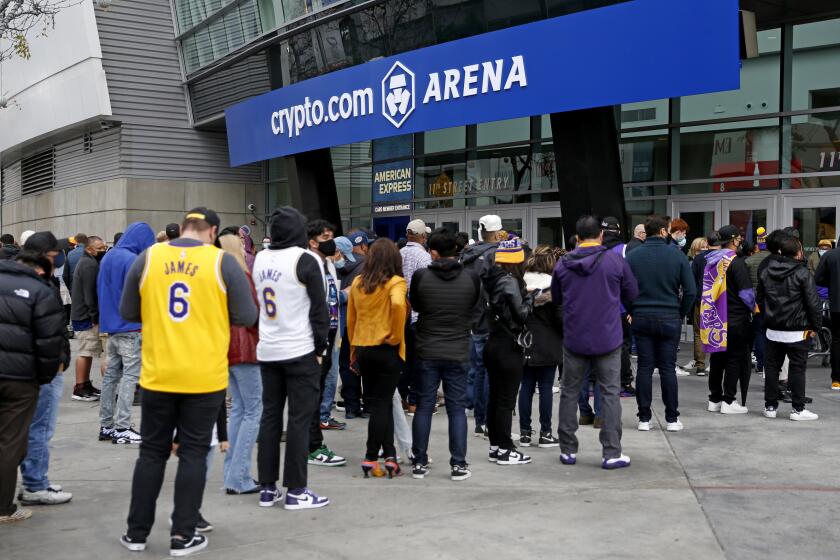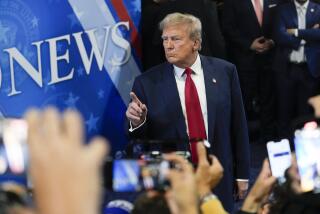Column: A cryptocurrency billionaire implodes, showing that the whole field is built on quicksand

- Share via
For a while there, Sam Bankman-Fried looked like the real thing.
Now 30, the MIT graduate had become the cryptocurrency ecosystem’s most visible and credible billionaire, with a fortune estimated at more than $26 billion at its peak.
Bankman-Fried looked like a political kingmaker, contributing nearly $900,000 to the Democratic National Committee in May 2022 alone.
The crypto folks say that crypto is somehow ‘different’ or ‘special’ because it’s technology, so it deserves to have its own special regulatory regime, which means a much lighter touch.
— Yevgeny Shrago, Public Citizen
He portrayed himself as a philanthropy-minded plutocrat, committing himself to donating 99% of his wealth to good causes and donating more than $100 million this year “to alleviate global poverty,” provide assistance to poor countries fighting the pandemic and fighting global warming, as he told a House committee in May.
His Bahamas-based company, FTX, was financially backed by major institutional and venture investors such as BlackRock, SoftBank and Sequoia Capital.
Get the latest from Michael Hiltzik
Commentary on economics and more from a Pulitzer Prize winner.
You may occasionally receive promotional content from the Los Angeles Times.
FTX bought the naming rights to the NBA Miami Heat’s home arena; employed NFL quarterback Tom Brady and his then-wife, supermodel Gisele Bündchen, as spokespersons; and had its insignia displayed on the uniforms of Major League Baseball umpires.
During the cryptocurrency meltdown earlier this year, Bankman-Fried’s trading firm, Alameda, helped to bail out several floundering crypto firms, including BlockFi and Voyager (the latter of which filed for bankruptcy before it could draw down more than $75 million of the $200-million loan Bankman-Fried offered the firm).
In the space of a couple of weeks in June, Bankman-Fried committed about $1 billion in bailout funds, according to an estimate by Bloomberg. The outlay had some crypto followers conjecturing that he meant to consolidate the industry in his own hands. Others compared him to J.P. Morgan, who masterminded a bailout of the securities industry during the 1907 financial crash.
That was a comparison that Bankman-Fried shyly welcomed, describing his bailouts as akin to a public service: “Something I thought was the right thing for the industry.”
Column: Shame, suicide attempts, ‘financial death’ — the devastating toll of a crypto firm’s failure
Customers of the bankrupt Celsius reveal how the cryptocurrency firm’s collapse upended their lives.
Through it all, Bankman-Fried projected a boyish aw-shucks persona, even appearing on stage before an August audience at a Bloomberg crypto conference with his trademark shock of unkempt curly hair and wearing a T-shirt and shorts.
At that conference — which took place in the teeth of the crypto meltdown — he even acknowledged, in his charmingly modest manner, the vacuum at the heart of the entire crypto system: No one has yet explained what bitcoin and other virtual currencies are good for in the real world.
“Certainly the asset price decline,” he said, “is a strong sign that in crypto ... things were way too light on use cases, and there’s a lot of hand-waving going on.”
Now, as it happens, Bankman-Fried and his companies are the ones angling for a bailout, with financial catastrophe looming should they fail.
On Tuesday, FTX agreed to be taken over by Binance, the world’s largest crypto trading firm, after a spurt in withdrawal requests from FTX depositors prompted the exchange to disclose a “backlog” in fulfilling the requests. On Wednesday, however, Binance backed out of the deal, apparently having discovered an insurmountable financial hole in FTX’s books.
The development raises doubts that Bankman-Fried’s empire, which once looked almost impregnable, can survive at all. How that will affect his firm’s depositors and investors isn’t clear but plainly isn’t encouraging.
Bankman-Fried had tweeted a promise that all depositors would be fully covered once Binance completed its due diligence examination of FTX’s books.
Bankman-Fried’s personal fortune has been immolated over only a few days of turmoil. Bloomberg estimates it currently at about $1 billion, based on the eradication in value of FTX, Alameda and their self-created virtual currency token, FTT.
These recent developments should give pause to lawmakers, such as Sens. Kirsten Gillibrand (D-N.Y.) and Cynthia Lummis (R-Wyo.), who have been buying into the crypto industry’s push for more indulgent regulations.
“The crypto folks say that crypto is somehow ‘different’ or ‘special’ because it’s technology, so it deserves to have its own special regulatory regime, which means a much lighter touch,” says Yevgeny Shrago, who follows the industry for the nonprofit public interest group Public Citizen. “There’s been a lot of momentum for that on Capitol Hill because crypto has had a lot of well-funded lobbyists showing up.”
Crypto was always reliant on the ‘bigger fool’ theory, and it has found its marks.
The recent crash in crypto values, he says, may wipe out a lot of funding for such political influence-peddling; the crash has brought the price of bitcoin, the emblematic cryptocurrency, down from its peak of nearly $70,000, reached almost exactly one year ago, to about $16,000.
Existing laws and regulations on the books of the Securities and Exchange Commission, Consumer Financial Protection Bureau, Commodity Futures Trading Commission and other government agencies should be sufficient to rein in the excesses of crypto firms, Shrago says; what Congress should do is provide those regulators with the financial resources they need to keep tabs on the industry.
As for Bankman-Fried’s elevation to the mantle of J.P. Morgan, what seems to escape those making the analogy is that Morgan had to step in to save the financial markets in 1907 because the markets operated chaotically with almost no government regulation and oversight and no provisions for consumer protection. Consequently, panicky depositors staged frequent runs on their banks.
That situation ended when the government finally lived up to its responsibility starting in the 1930s — creating a solvent Federal Reserve System and imposing consumer- and investor-friendly regulations, among other things.
To characterize Bankman-Fried as a Morgan-like savior is to acknowledge that the crypto system is, at its core, a dysfunctional and distinctly consumer-unfriendly Wild West.
Although the cryptocurrency space can appear bewilderingly opaque and high-tech to outsiders, the events that brought FTX to its crisis have an old-fashioned feel. They boil down to a run on the bank not much different from those that afflicted banks in the old days.
The firm’s problems started Nov. 2, when the crypto news service CoinDesk published an analysis of a leaked Alameda balance sheet stating that its disclosed assets of $14.6 billion included some $6 billion in FTT.
As CoinDesk explained, “Bankman-Fried’s trading giant Alameda rests on a foundation largely made up of a coin that a sister company invented, not an independent asset like a fiat currency or another crypto.”
Four days after the balance sheet report, Binance’s chief executive, Changpeng Zhao (who is known in the trade as “CZ”), announced that his firm would liquidate its entire holding of 23 million FTT tokens, then valued at about $529 million.
Zhao attributed his decision to “recent revelations that have come to light,” seemingly a reference to the CoinDesk disclosure. His statement seemed to fit in with a long history of cryptocurrency conflict between him and Bankman-Fried.
A cryptocurrency company thinks it will get a boost from putting its name on the Lakers’ arena. History begs to differ.
A torrent of $6 billion in withdrawal orders from FTX customers over three days followed Zhao’s announcement, creating what Zhao labeled a “significant liquidity crunch” at FTX that prompted his offer to take over the smaller company and cover its customer obligations.
At first, Bankman-Fried and his associates tried to minimize the impact of the CoinDesk article. The balance sheet in the report was for “a subset of our corporate entities,” Alameda CEO Caroline Ellison tweeted, adding that the firm had more than $10 billion in assets that CoinDesk hadn’t counted.
After Zhao announced his FTT sales, Ellison offered, again by tweet, to “buy it all from you today at $22!” (The FTT token, which was priced as high as $85 in September 2021, has been quoted most recently at $3.55 by Coinbase, a crypto exchange.)
At this moment, the crypto meltdown, including Bankman-Fried’s implosion, hasn’t caused even a ripple in conventional financial markets, largely because the crypto market is still relatively small compared with traditional stock and bond markets, and traditional banks have generally steered clear.
Yet crypto enthusiasts still harbor ambitions to become a larger factor, even to supplant conventional currencies and financial instruments. Fidelity Investments has even established a system to allow workers to invest in crypto through their 401k retirement plans. (Employers would still have to allow it and the Labor Department, which oversees such plans, warns against it.)
Just now, there doesn’t seem to be much left of Bankman-Fried’s personal ambitions other than the shards of his regulatory proposal, presented so self-confidently to the House Agriculture Committee on May 12. He called it a “safe and conservative” model that would foster “competition and innovation” in U.S. financial markets.
In response, Terrence A. Duffy, the CEO of CME Group, the world’s largest financial derivatives marketplace, warned that Bankman-Fried’s model was a lightweight regulatory regime that would “inject significant systemic risk into the U.S. financial system.”
It’s fair to say that Duffy, no less than Bankman-Fried, was speaking on behalf of his own interests. But it’s also fair to say that given current circumstances, crypto’s doubters have the better argument.
More to Read
Get the latest from Michael Hiltzik
Commentary on economics and more from a Pulitzer Prize winner.
You may occasionally receive promotional content from the Los Angeles Times.














